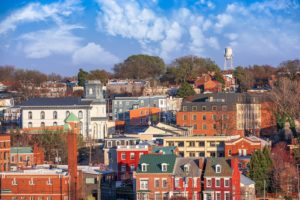Midlothian, Virginia
Chesterfield County, Virginia, is home to Midlothian, an unincorporated portion of the county. It was once a coal town that had undergone suburbanization and is now a part of Richmond’s western suburbs across the James River. The unincorporated status of Midlothian makes it impossible for it to have a formal government, so the original Midlothian village and much of Chesterfield County in the north part of Southside Richmond are represented by the Midlothian post office.
Midlothian has a population of 72,711 individuals in 2020, distributed among 26,206 families. 49.6% of the people (50,584) are white, 13.9% (10,095) are black, 4.4% (3,203) are Asian, 0.3% (206) are Native American, 0.05% (41) are Pacific Islanders, 4.7% (3,412) are of other races, and 7.1% (5,170) are of two or more races. 8.9% (6,496) of the population are Hispanic or Latino. The average family made $89,851 in 2019.
By the early 18th century, French Huguenots and others were developing mines in Chesterfield County. Coal owners began exporting their goods from the area as early as the 1730s. The U.S. White House was heated using Midlothian-area coal from Harry Heth’s Black Heath mines for President Thomas Jefferson. The transportation demands of coal shipping spurred the creation of Virginia’s first paved toll road, the Manchester Turnpike (1807); the Chesterfield Railroad (1831), Virginia’s first railroad; and the railroad from the mines to Manchester, Virginia’s first port town, near the Fall Line of the James River. These all contributed to the region’s economy. In 1850, the Richmond and Danville Railroad constructed Coalfield Station, a freight and later passenger station near the mines.
Coal mining in the 20th century diminished. The area retained its wooded character, with small farms scattered throughout. As metropolitan Richmond expanded after World War II, residential subdivisions sprang up. As a result of the creation of Swift Creek Reservoir in 1965 and the availability of water and sewer service, Brandermill was built in 1975.
According to the Chesterfield County Midlothian Community Special Area Plan, the Midlothian community is defined as a region from the Village of Midlothian to Lucks Lane to the south. A new highway link and an extension of Powhite Parkway and Midlothian Turnpike (U.S. Route 360) were built in 1988 to accommodate traffic. The expansion of the area designated for the Midlothian post office resulted in a dramatically expanded ZIP code service area. Because of this, many people living in Chesterfield County and far from the original Midlothian village on U.S. Route 60, which is situated near U.S. Route 60, prefer the name ‘Midlothian’ for their address.
Because of the addition of the multimillion-dollar Bon Secours Hospital, St. Francis, Midlothian is now home to a major hospital within five minutes of Midlothian’s highest concentration of residents.
Chesterfield County Public Schools’ James River High School received the President’s Blue Ribbon School of Excellence Award in 2000. Cosby High School, also located in Midlothian, received this recognition in 2015.
The Chesterfield Museum offers a glimpse into local mining history with a display featuring a section of iron rail from the incline railway, the first in the state.
In the cult film Donnie Darko, Middlesex, Virginia is based in Midlothian, Virginia. According to filmmaker Richard Kelly, Middlesex is a comic-book fantasyland version of what he remembered Midlothian to be like.
For Technology Assurance Group‘s services in Midlothian, check out IT Support Midlothian.


